RASCAL sped across the riffled waters of Long Island Sound. Her mahogany foredeck glowed from the depths of its varnish, and her stainless-steel cutwater sparkled through drops of water streamlining into mist. Driver and passenger sat low on a simple rolled leather seat, legs stretched out nearly parallel to the cockpit sole. A tall person could reach over the side and touch the water as it rushed aft at better than 50 mph. Memories of my first ride in RASCAL still raise goose bumps after 15 years.
At 15′ in length and weighing about 1,000 lbs with a full fuel tank and cockpit, RASCAL is a cheeky little boat— “pleasantly mischievous” is one of the ways Merriam-Webster’s Unabridged Dictionary defines the name—powered by a 60-hp Mercury outboard. If Colin Chapman had designed and built boats instead of Lotus automobiles, a boat of RASCAL’s character surely would have been among them—the Lotus Super Seven of the waterways.
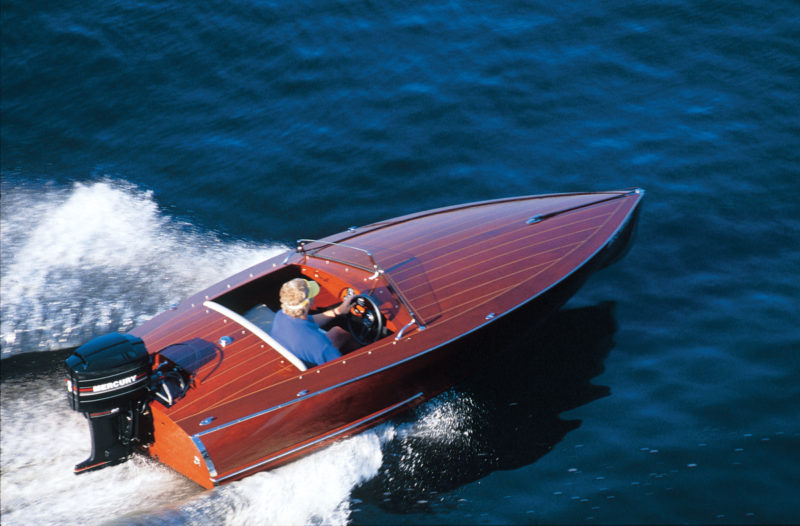 Photo by Polly Brown
Photo by Polly BrownRascal, a 14’10” outboard runabout that you can build in the backyard, strives to capture the cachet of big mahogany speedboats—without their mechanical complications and great expense.
Designed and built by Kenny Bassett, Onion River Boat Works, RASCAL offers more bang for the buck than just about any other runabout a father and son could build over several hundred hours of nights and weekends. They will build her of plywood—4mm for the topsides and decks, 5mm for the bottom—ripped into strips 1″ wide and laid diagonally over frames and stringers. That’s the easy part. If they want to capture the gloss and romance of traditional mahogany runabouts, they’ll plank the topsides with 1⁄ 4″ solid mahogany, perfectly lined off and set in epoxy. Although this method taxes the skill and patience of an amateur builder, it’s far from impossible. In fact, Tom Donahue, an electrical engineer living in Connecticut, recently completed a Rascal. Before this project, he’d built nothing more demanding than a couple of birdhouses. Donahue knows, maybe better than anyone, that whoever builds a Rascal must let patience guide them throughout the project, especially during the varnishing. The finishwork will likely require as much, or more, time than the construction.
The final result, though, is worth the wait. RASCAL rides atop a shallow-V bottom. Her steep entry warps into a flat run and ends at the transom in a deadrise of about 7 degrees. A delta-shape pad keel from station No. 2 aft to the transom provides a perfect planing surface, allowing RASCAL to make the transition from displacement speed to full plane in a single heave—absent the “hump” we associate with deep-V hulls and their slightly shallower modified-V sisters. Chine flats emerge from the waterline at station No. 4, which corresponds with the forward edge of the cockpit. They rise gracefully and embrace the stem about halfway up the bow, forming a line that plays with light and shadow to create visual interest forward of the cockpit. These chines also deflect spray.
RASCAL’s exceptional proportions mask her size when she stands alone in the slip or speeds across the water. Only when she’s parked next to a larger boat does she reveal her compact dimensions. The outboard’s power head, like a welt on the forehead of Julianne Moore, may diminish our first impressions from exquisite to merely beautiful, but familiarity ought to heal the wound. Bassett was aware of this possibility, so he painted the cowling of the outboard on hull No.1. A lustrous solid black accented by the name RASCAL in chromed script made the power head an integral part of the design, further defining the boat’s character and purpose.
I’d met Bassett at the Riverside Yacht Club in the town of the same name located two train stops east of Greenwich, Connecticut. He’d traveled from New Hampshire to demonstrate the boat to a prospective buyer and invited me to join him for a test drive afterward. Bassett fired up the three-cylinder Mercury, which was still warm from his demo, engaged forward gear, and idled us into the channel.
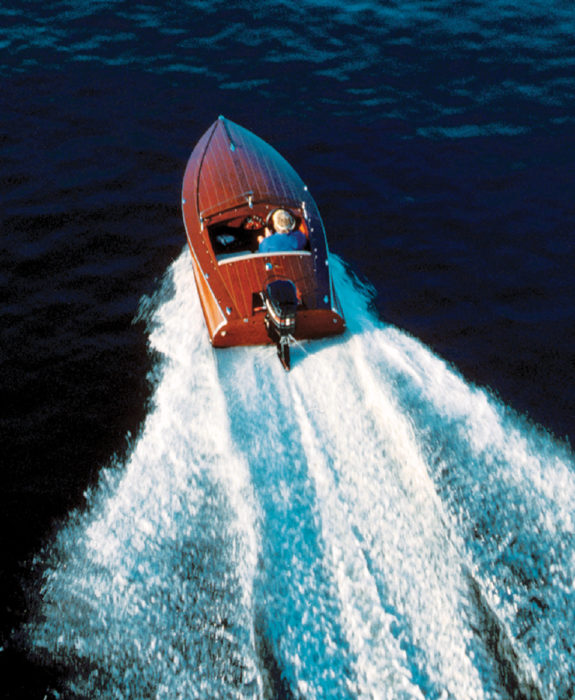 Photo by Polly Brown
Photo by Polly BrownPowered by a 60-hp, Mercury outboard motor, RASCAL scoots along at better than 50 mph.
At rest and under slow way, RASCAL lightly tap-danced to the rhythm of cat’s-paws stirred by the breeze. This lateral motion is common to other runabouts I’ve driven and seems to be a characteristic of the bottom’s shape and the boat’s low center of gravity. I love this little dance, because it conveys a restless energy—the promise of speed. Most runabouts fulfill this promise, whether they are blindingly fast or simply pleasingly rapid.
Few powerboats involve us in their playfulness as completely as does a fine runabout, and RASCAL’s length and light weight intensify all of the sensations—save one: the rumble of an inboard engine, V-8, or straight-six barking epithets from the chrome tips of a through-transom exhaust. When I drove the original RASCAL, a 60-hp Mercury two-stroke outboard powered her, and I admit to being disenchanted by the ring, ding, ding voice coming from the transom. Sure, I knew better. I had road-raced two-stroke motorcycles in the late 1960s and early 1970s, and understood their potential to entertain the speed demon in all of us. I knew also that this lightweight outboard was the key to RASCAL’s personality.
Never mind Gar Wood’s neat 16′ Speedster inboard runabout or, to be more contemporary, Donzi’s lovely Sweet 16 sterndrive, only an outboard would give Bassett everything he wanted—simplicity of installation, ease of maintenance, purchase price, light weight and performance. Although outboard-powered classics never gained the cachet of their inboard sisters, they’ve written a richly colorful history for themselves in racing and more sedate forms of boating. In RASCAL, Bassett has combined the spirit of the all-conquering Switzer Craft hydroplanes and utilities with the look and presence of a Gold Cup raceboat.
After we cleared the mooring field and the no-wake zone, Bassett trimmed the outboard’s drive leg and pushed the throttle to the stops, sending us in a single rush to a speed of 50 mph. In the open water, RASCAL skimmed atop a foot or so of chop, doing her best imitation of a Lotus Super Seven tearing along a country lane in the north of England. Hard left, hard right, the little boat put her shoulder into the turns and carved perfect arcs. A tiny skid fin, at the leading edge of the planing surface and projecting to a depth of 2 3⁄4″ from the pad keel, helped RASCAL hold her line and speed in these turns. Without the fin, she would drift wide—her way of asking the driver to back off the throttle. We played until our faces ached with indelible grins and the electric tilt and trim on the outboard quit working.
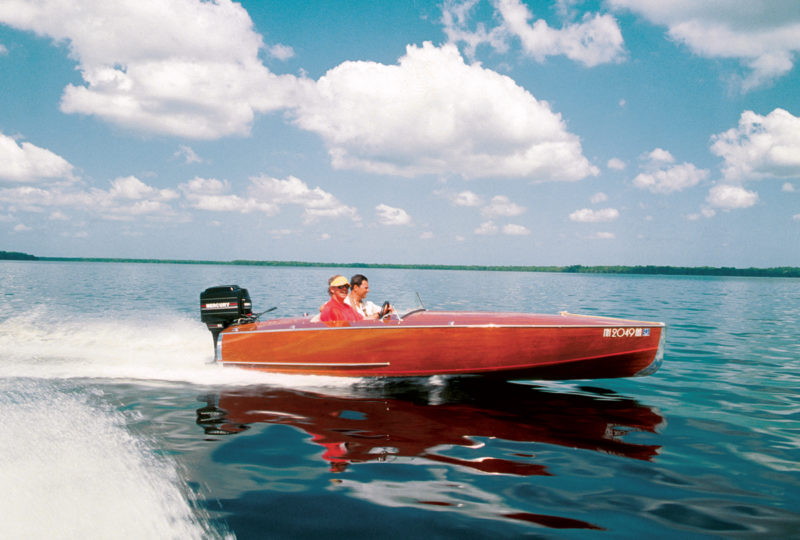 Photo by Polly Brown
Photo by Polly BrownDesigner-builder Ken Bassett drives RASCAL at speed. The playful runabout isn’t the easiest boat to build, but she rewards careful work with fine performance and head-turning appearance.
We met again later in the summer—this time on Candlewood Lake, near Danbury, Connecticut. This lake is an impoundment and is very narrow in many sections. Wind-blown waves and the wakes of powerboats bounce off the shorelines and march directly back toward the center of the lake. Picture the inside of a washing machine, the agitator of which moves rapidly up and down. Even during the week, motorboat traffic on Candlewood resembles the madness of I-95 between New Haven and Greenwich, so we looked for relatively quiet water to time her acceleration and top speed in fresh water. We recorded 2.7 seconds from 25 to 35 mph and a maximum speed of 52 mph.
My turn to drive. The cockpit is intimate, the steering wheel small, and the gauges are located in a panel at the center of the dashboard, similar to the arrangement in a 1952 Jaguar XK120. The seat is a paragon of simple design and construction, a pair of leather-covered foam cushions resting on nylon webbing. As drawn, the cockpit ought to accommodate a reasonable variety of human heights and widths. If I were going to build a Rascal, I’d figure out a way to make the seat adjustable fore-and-aft.
The unassisted cable-operated steering was quick, and RASCAL’s response nearly instantaneous. At first, the boat’s quickness startled me, so I eased back on the throttle until I got the feel of her handling. In those washing machine waters, she preferred staying on top of the conditions, so the faster we went, the smoother was her ride. RASCAL reacted predictably to changes in the outboard’s trim. Trimming in brought the bow down to engage the waves; trimming out raised the bow, transferring the load to her planing surface under the cockpit. She never porpoised, chine-walked, or tried to get airborne. One owner of a Rascal has clamped a heavily modified outboard onto the transom and regularly sees 70 mph. He has reported that she remains free of handling vices.
Like a pleasingly mischievous friend, RASCAL defies anyone to resist her charm, her playfulness, and friendly manners. She may not be the easiest boat to build, but rendering the two-dimensional drawings into all her wonderful three-dimensional shapes may make you as giddy as does driving her.
Ken Bassett retired and closed Onion River Boatworks in 2017; there are no plans available for RASCAL. The review is presented here as archival material.
Is there a boat you’d like to know more about? Have you built one that you think other Small Boats Magazine readers would enjoy? Please email us!
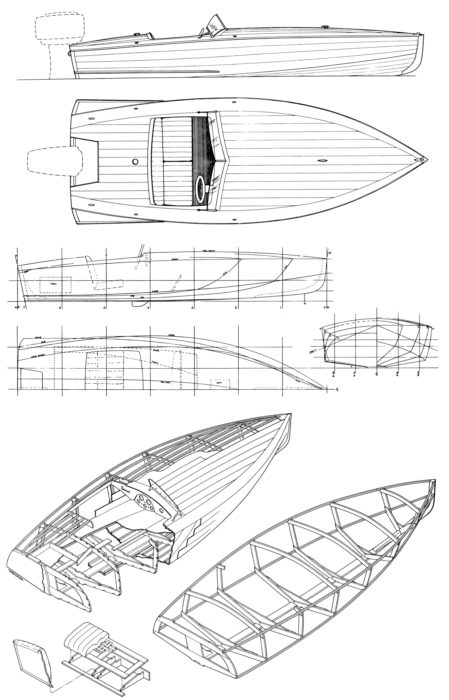
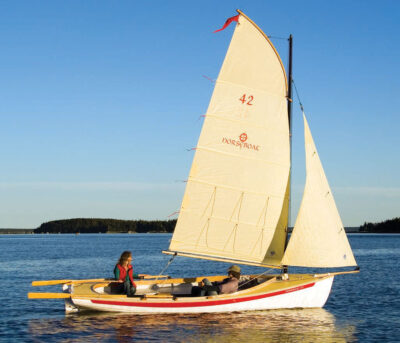
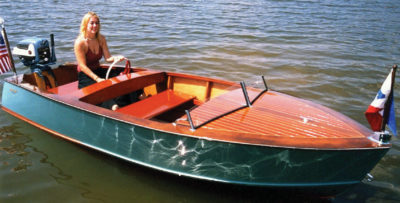
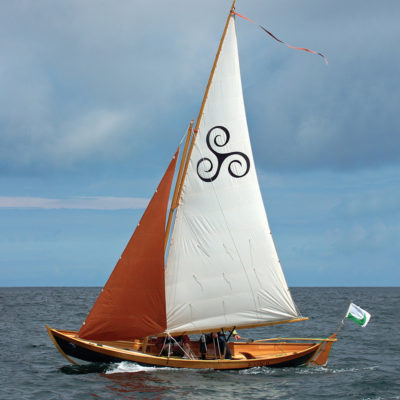
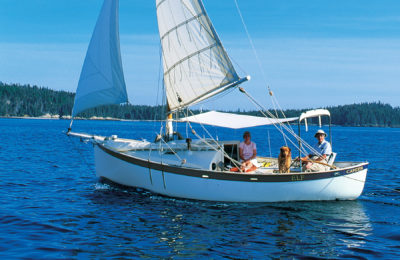
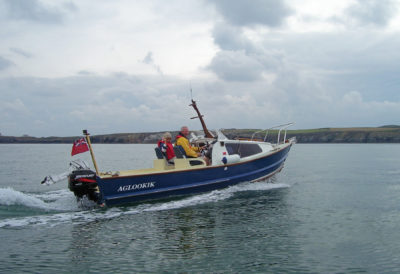
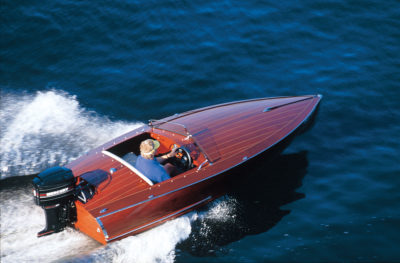
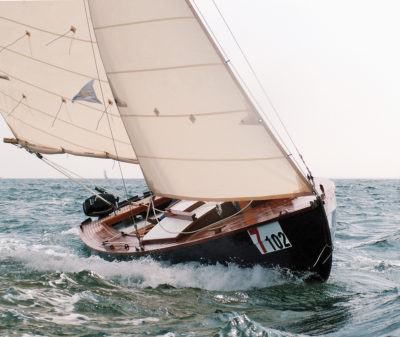
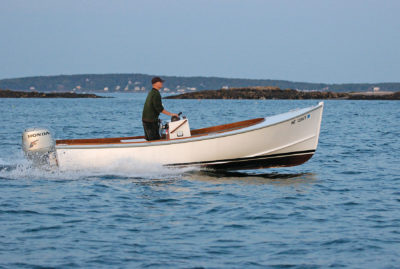
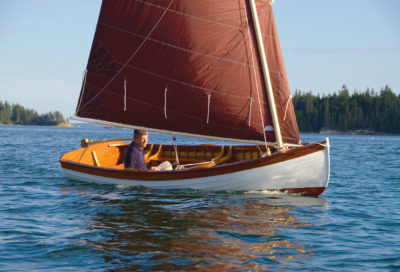
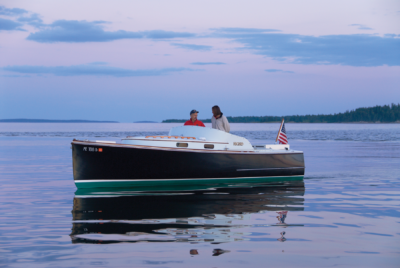
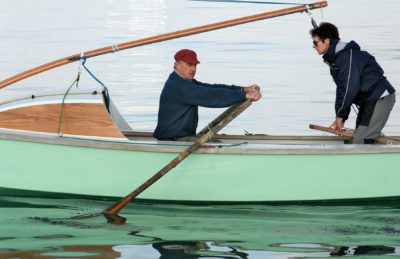
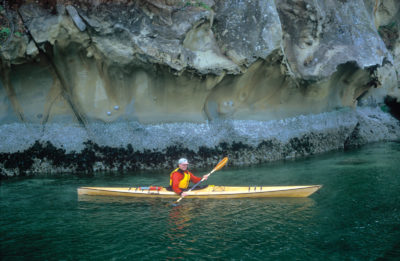
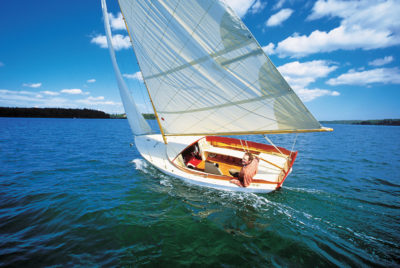
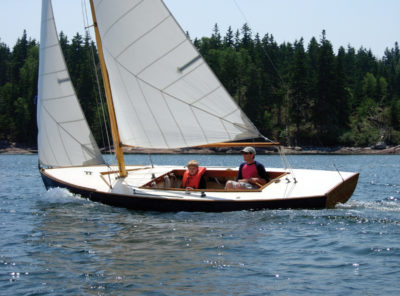
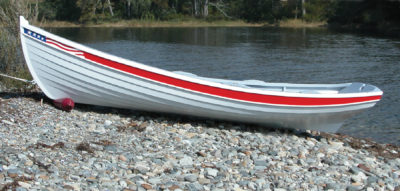
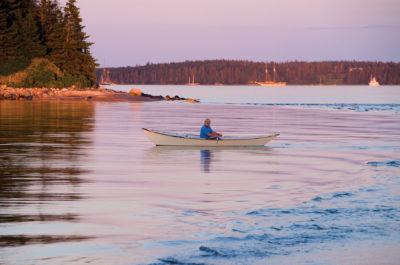
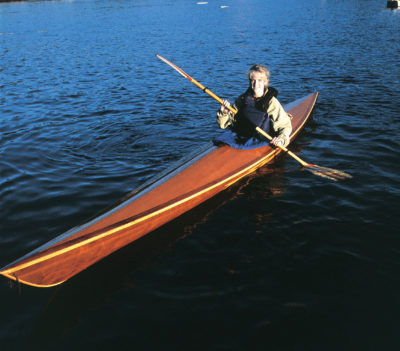
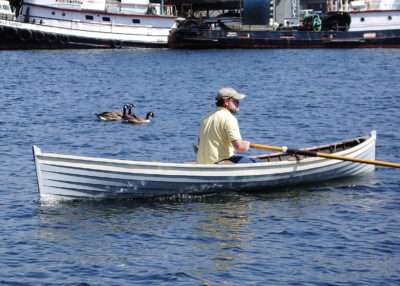
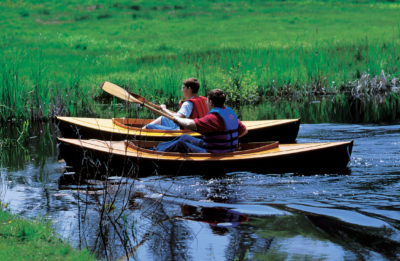
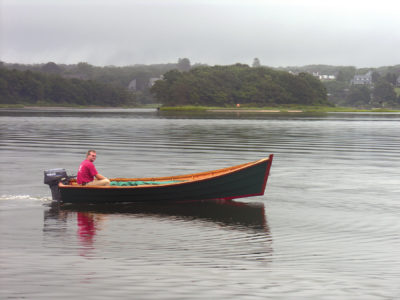
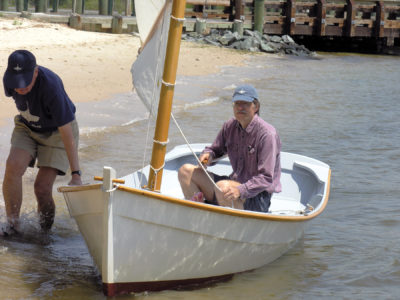
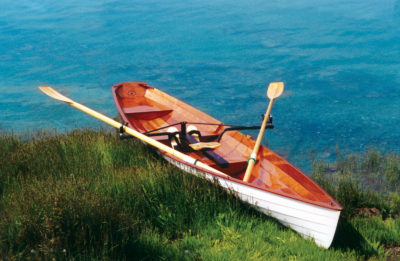
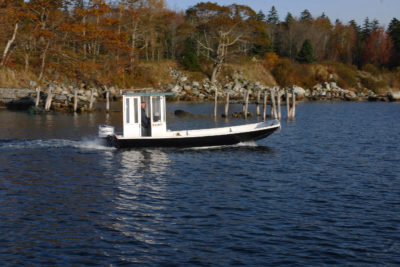
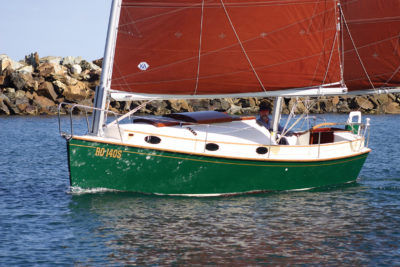

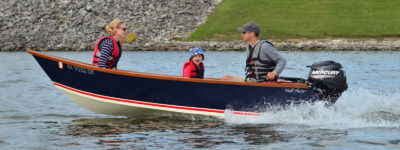
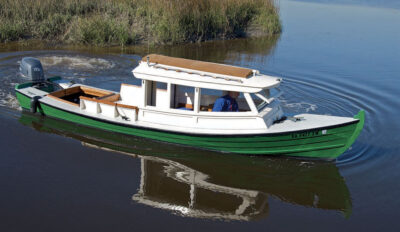
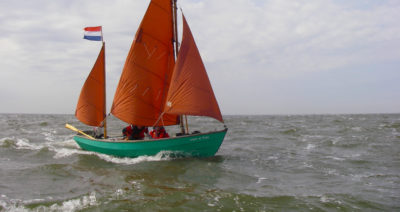
I built Rascal in 1998. It was challenging but very rewarding and I also installed a 60HP Mercury. As I wanted to move on to other projects, I sold the boat. Some years later I completed a 26′ triple-cockpit runabout that I brought to a wooden boat show in Lake Hopatcong, N.J. where the same Rascal was on display!
Great article, inspiring.
Thanks
JP
I am currently building a Ken Bassett Rascal. I have talked to Ken several times for advice as well as the WoodenBoat community. Everyone was very helpful.
I am a first-time boat builder with several years of WoodenBoat school classes to support my endeavor.
I am enjoying the challenge. If you are building a Rascal boat or thinking about building, please reach out to discuss.
Hello,
What do you estimate the cost of materials to be for this design? Could the boat be designed for two smaller outboards?
What a gorgeous little boat!
I’m intending to build one as soon as I’ve finished fixing up a put-put I’ve restored, but the engine is a disaster. The Minister of Home Affairs has dictated this must be completed first! It’s called One Day which may give a clue to the directive.
I’m in Australia, so talking with Ken may be an issue, is there an email address through which I could contact him?
A very dear friend purchased a Rascal that has the natural wood with a light-blue side accent color.
What a pleasant surprise when he brought it to the lake. The gentleman who built it produced a fine piece of furniture. The workmanship is second to none. The wood absolutely glistens and the painted accent stands out. When he drives his Rascal along the shoreline, it has all of the embodiment of a classic runabout.
The ride can only be stated as: EXHILARATING!
You cannot appear graceful when boarding, but the payoff is a lot of fun on the water.
My dad built a 15′ Rascal in 1985 which we now must have valued for his estate. Would anyone be able to give me some idea as to the market value? It’s in excellent shape.
Where can I get plans for the Rascal?
The Rascal article was originally published in 2012 and we added this note to the end of it for this second appearance:
Ken Bassett retired and closed Onion River Boatworks in 2017; there are no plans available for RASCAL. The review is presented here as archival material.